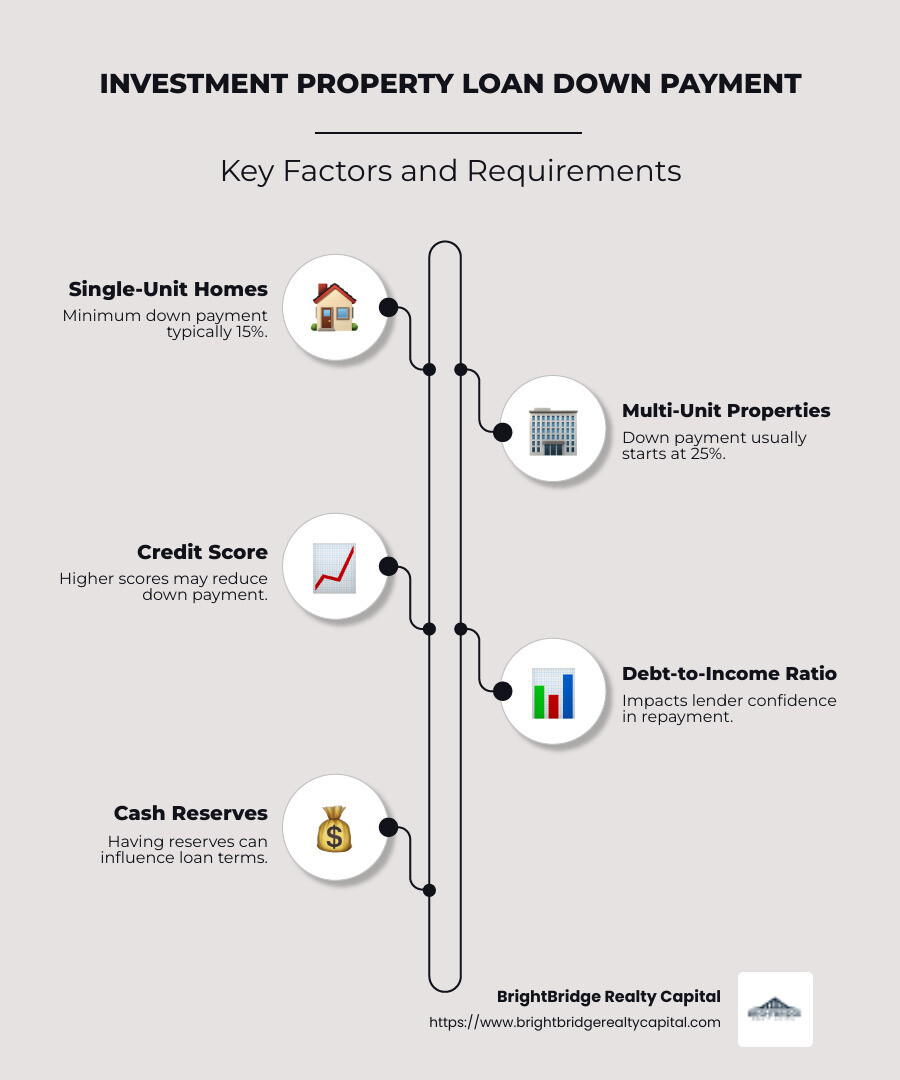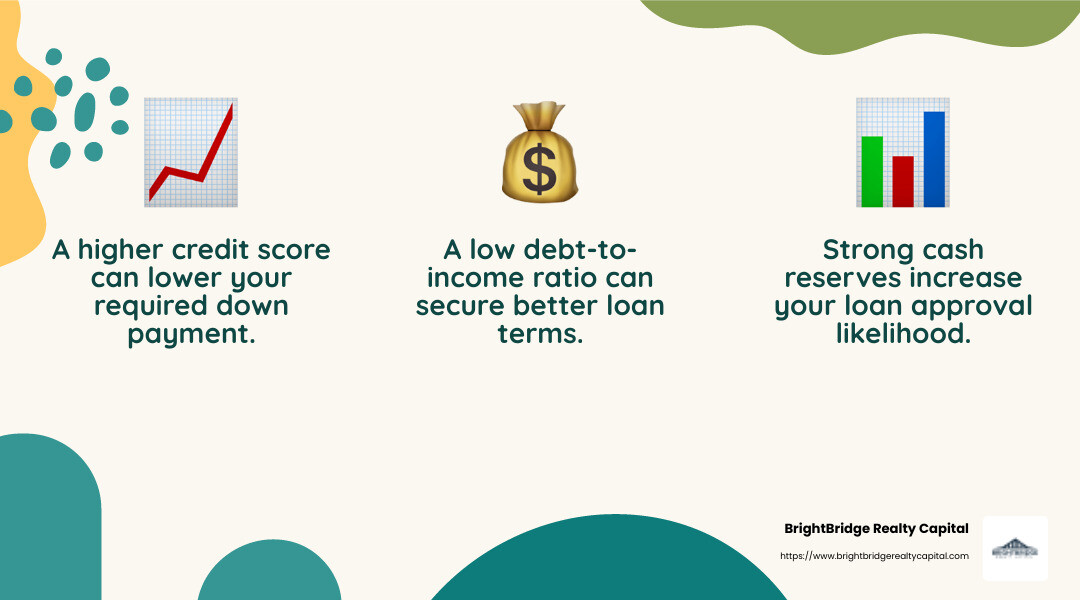The Down Low: Investment Property Loan Down Payments Explained

Investment property loan down payment requirements can be a crucial factor for real estate investors seeking quick financing solutions. Here's a quick overview:
- Single-unit homes: Minimum down payment is typically 15%.
- Multi-unit properties (2-4 units): Down payment often starts at 25%.
- Factors that can impact down payment: Credit score, debt-to-income ratio, and cash reserves.
Real estate investing requires smart financial strategies, especially when it comes to securing the right loan. BrightBridge Realty Capital understands the frustrations that investors face with slow loan processes and high rates. For those looking to expand their rental portfolios or jump into fix-and-flip projects, understanding down payment requirements is key to open uping investment potential.
We’ll explore the different aspects of investment property loans, from down payment requirements to various financing strategies. By the end, you'll know how to steer through the options available and make informed decisions for your property investments.

Essential investment property loan down payment terms:
- investment property loans with no down payment
- low down payment rental property loans
- ways to finance a rental property
Understanding Investment Property Loan Down Payments
When diving into real estate investing, understanding the investment property loan down payment is crucial. This section breaks down the essentials, from minimum requirements to factors influencing the amount you'll need.
Minimum Down Payment Requirements
The down payment for an investment property generally falls between 15% to 25% of the property's purchase price. This range can vary based on several factors, including the type of property and the lender's specific criteria.
- Single-unit homes often require a minimum down payment of 15%.
- Multi-unit properties (such as duplexes or triplexes) typically start at 25% down.
These requirements are influenced by guidelines set by entities like Fannie Mae and Freddie Mac, which back many of the conventional loans available to investors.
Factors Influencing Down Payment Amount
Several key factors can affect the exact down payment you’ll need to make:
Credit Score: A higher credit score can open the door to lower down payment options and better loan terms. Lenders see high credit scores as a sign of reliability.
Debt-to-Income Ratio (DTI): This ratio compares your monthly debt payments to your monthly income. A lower DTI ratio can make lenders more comfortable with a smaller down payment.
Cash Reserves: Having substantial cash reserves can also influence your down payment. Lenders may require proof of reserves to ensure you can cover unexpected expenses or vacancies.

By understanding these factors, you can better prepare and potentially reduce the amount you need to save for your investment property.
Navigating investment property loans can be complex, but having a clear grasp of these requirements and factors can help you make informed decisions as you expand your real estate portfolio.
Next, we'll explore strategies to lower your investment property loan down payment, including creative financing options.
Strategies to Lower Your Investment Property Loan Down Payment
When it comes to reducing your investment property loan down payment, there are a couple of strategies that can be particularly effective: house hacking and government-backed loans. These options might allow you to get started in real estate investing without needing to save up a massive amount of cash upfront.
House Hacking
House hacking is a smart strategy where you buy a property with multiple units, live in one of them as your primary residence, and rent out the others. This approach can significantly reduce your housing costs and, in some cases, cover your entire mortgage payment with the rental income from tenants.

The beauty of house hacking is that it allows you to qualify for loans typically reserved for primary residences, which often have lower down payment requirements. For example:
FHA Loans: With as little as 3.5% down, you can purchase a property with up to four units if you live in one. This makes it much easier to break into real estate investing without a huge upfront investment.
VA Loans: If you're eligible, a VA loan allows you to buy a one- to four-unit property with 0% down, provided you live in one of the units. This is an incredible opportunity for veterans to start building wealth through real estate.
Government-Backed Loans
Government-backed loans like FHA and VA loans are not just for first-time homebuyers—they can also be used for investment properties under certain conditions.
FHA Loans: As mentioned, these loans are a great option for properties with up to four units. They require you to occupy one unit as your primary residence, which aligns perfectly with the house hacking strategy.
VA Loans: Exclusively for veterans, these loans offer the chance to purchase a multi-unit property with no down payment, making them an excellent choice for those who qualify.
These loans are designed to make homeownership more accessible and can be a game-changer if you're looking to reduce your initial cash outlay when purchasing an investment property.
By leveraging these strategies, you can potentially lower the barrier to entry for real estate investing and start building your property portfolio with less financial stress.
Next, we'll dive into alternative financing options for investment properties, including HELOCs, private lenders, and self-directed IRAs.
Alternative Financing Options for Investment Properties
If you're looking to invest in real estate but want to explore beyond traditional loans, there are several alternative financing options to consider. These options can help you secure funds for your investment property without requiring a large upfront down payment. Let's explore three popular choices: Home Equity Line of Credit (HELOC), private lenders, and self-directed IRAs.
Home Equity Line of Credit (HELOC)
A HELOC allows you to tap into the equity of your primary residence to finance an investment property. Essentially, you're borrowing against the value of your home, which can be a savvy way to fund your real estate ventures.
How it works: Lenders typically allow you to borrow up to 80% of your home's equity. This means if your home is worth $300,000 and you owe $200,000, you could potentially access $80,000.
Benefits: HELOCs offer flexibility with a revolving line of credit, allowing you to draw funds as needed. Plus, they often come with lower interest rates compared to other loan types.
Considerations: Using a HELOC increases the real estate debt on your primary residence. If the investment doesn't go as planned, you risk losing your home.
Private Lenders
Private lenders can be a flexible and accessible option for financing investment properties. Unlike banks, these lenders are individuals or companies willing to offer loans with terms that might suit your specific needs.
How it works: Private loans are often based on the property's potential rather than your credit score. This can be beneficial if your credit isn't perfect.
Benefits: These loans can be quicker to secure, with more flexible loan terms and conditions. This is particularly useful if you're in a time-sensitive situation.
Considerations: Interest rates are generally higher with private lenders, and the repayment terms might be shorter. It's essential to ensure that the investment property can generate enough income to cover these costs.
Self-Directed IRA
A self-directed IRA allows you to use your retirement funds to invest in real estate. This option can be a powerful way to diversify your retirement portfolio.
How it works: By converting a traditional IRA or 401(k) into a self-directed IRA, you gain the ability to invest in various assets, including real estate. The property is owned by the IRA, and any profits go back into the retirement account.
Benefits: This method offers potential tax advantages, as the funds grow tax-deferred. You can also use this strategy to build wealth for retirement without affecting your current finances.
Considerations: Managing a self-directed IRA involves strict tax compliance and paperwork. All expenses related to the property must be paid from the IRA, and any personal use of the property is prohibited.
These alternative financing options provide creative ways to fund your real estate investments. By leveraging your existing assets or exploring flexible lending terms, you can enter the real estate market with less upfront cash and more confidence.
Next, we'll address some frequently asked questions about investment property loan down payments.
Frequently Asked Questions about Investment Property Loan Down Payments
What is the typical down payment for an investment property?
When it comes to investment property loan down payments, the typical range is between 15% to 25% of the property's purchase price. This range can vary based on several factors, including your credit score, the lender's specific requirements, and the type of property you are investing in.
For instance, loans backed by Fannie Mae and Freddie Mac often require a minimum down payment of 15% for a single-unit investment property. However, for properties with two to four units, a down payment of 25% might be necessary. The loan-to-value (LTV) ratio and your overall financial profile play significant roles in determining the exact percentage needed.
Can I use rental income to qualify for a loan?
Yes, rental income can be a valuable asset when qualifying for an investment property loan. Lenders often consider both your rental history and market rents in the area to determine your eligibility. If you already own rental properties, providing a solid rental history with consistent income can strengthen your loan application.
For new properties, lenders might use estimated market rents to assess potential income. Though, that not all lenders accept rental income as a qualifying factor, so it’s important to confirm with your chosen lender.
How can I avoid a large down payment?
If you're looking to avoid a hefty down payment, there are a few strategies you can consider:
House Hacking: This involves purchasing a property with multiple units, living in one, and renting out the others. By doing this, you can often qualify for a mortgage designed for a primary residence, which might allow for a smaller down payment. For example, FHA loans require as little as a 3.5% down payment if you occupy one of the units.
Government-Backed Loans: Programs like FHA and VA loans offer lower down payment requirements. An FHA loan, for instance, allows you to put down as little as 3.5% if you meet certain criteria. VA loans, available to eligible veterans, can even offer 0% down options.
These methods can help you enter the real estate market without the burden of a large upfront investment, making it easier to start building your property portfolio.
Conclusion
Navigating investment property financing can seem daunting, but it doesn't have to be. At BrightBridge Realty Capital, we specialize in making real estate financing straightforward and accessible. Whether you're a seasoned investor or just starting, we offer custom solutions that fit your unique needs.
Our approach is simple: provide quick funding with flexible terms. We understand that timing is crucial in real estate, and that's why we pride ourselves on fast closings—often within a week. This speed ensures you can seize opportunities as they arise without unnecessary delays.
Our nationwide reach means that no matter where your investment property is located, we've got you covered. By cutting out intermediaries, we offer competitive rates and a seamless process, making your financing experience as smooth as possible.
If you're ready to explore your options and take the next step in your real estate investment journey, contact us at BrightBridge Realty Capital today. Let's make your investment goals a reality with the right financing solution.


